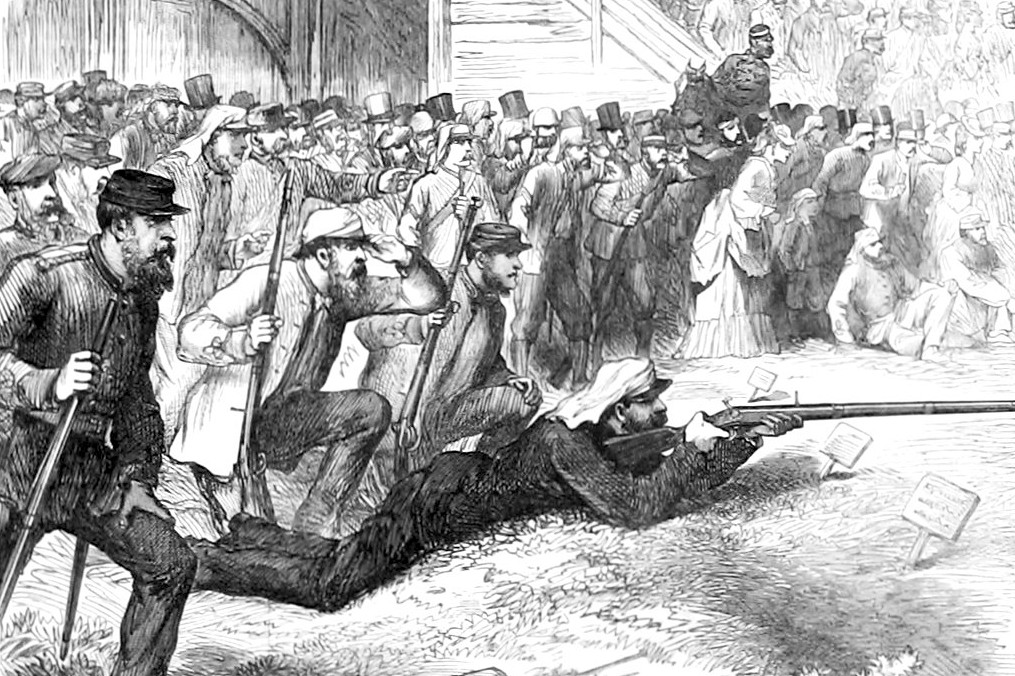What is long range? > Historical & Literary References > Mechanically Fitting Bullets > Developments in France > Long Range Shooting
The Coming of the New Age
The first essays into improving range were connected with the use of mechanically fitting projectiles. The idea was not new, it crops up at intervals for well over one hundred years. The ENCYCLOPAEDIA BRITANNICA in the Edition of 1810 discusses at some length the construction of light artillery using spherical ball with studs fitting the rifling. These guns were developed by Doctor Lind and Captain Alexander Blair of the 69th Foot as far back as 1774. The Carron Company were making a one pounder of this description weighing 100 pounds. It was rifled with six semi-circular grooves making one turn in the barrel. To increase their accuracy they were fitted with a telescopic sight incorporating an elevating arc which they called a Collimeter. The British Government adopted the idea of the mechanically fitted projectile with the Brunswick Rifle introduced in 1837.
We have seen that the spherical ball carried its own limitation of range and therefore the only option open was the elongated projectile. In spite of this, the idea of augmenting the weight of the ball by increasing its diameter lingered on and in the British Service the last dying kick of the principle surfaced as late as 1840 in the form of the Heavy Naval Brunswick Rifle. This was .796 calibre (as opposed to the .702 of the army model) with two groove rifling. Fortunately, only one hundred were made of which ninety were actually issued and remained as official stores until the 1860s. Six were used in trials at the Naval Gunnery School, H.M.S. Excellent. The trial records for these may well still exist. In actual practice, using one of these rifles with exactly duplicated bullets and charges a few years ago, we found that the results were wildly inaccurate at 200 yards. The sight leaves are unmarked on all the specimens that have been seen but they were recommended by Captain Sir Thomas Hastings of H.M.S. Excellent to be marked up to 470 yards. What sort of results could have been obtained at that range is hard to imagine. They might perhaps have been able to land some balls somewhere on a three decker Line of Battle Ship.
The London Gunmaker, Staudenmayer, made air rifles with mechanically fitting bullets before 1820 and this idea was taken up by Captain Norton, an undoubted pioneer in the advancement of long range shooting. Sadly, he suffered throughout his life from a lack of official recognition. A study of his written work suggests that however good his ideas, his methods of promoting them were the probable reason for his lack of success.
A veteran of the Peninsular, Captain Norton was serving in New South Wales and in India from 1815 to 1823 with, one suspects, very little to do. Turning his attention to ballistics, and possibly having a knowledge of Robins’s theories, he arrived at the conclusion that elongated projectiles in rifle barrels were the answer. His rifle shells were rounded at both ends and fitted with studs to engage the rifling. He was obsessed with the shell principle, in order to blow up enemy caissons or ammunition wagons at a distance. The experience of being under the fire of Napoleon’s efficient artillery may have had something to do with this. During 1824 he developed the idea in a German made thirteen groove rifle of eleven bore and using this rifle he demonstrated in the Spring of 1826 to the Ordnance Select Committee at Woolwich at 120 yards. The same week he attended Addiscombe, the Academy of the East India Company, and Sandhurst where he gave similar demonstrations. At Addiscombe he blew up an ammunition box in the presence of the entire staff and students one of whom was the fourteen year old John Jacob in his first year there.
Jacob went off to India in 1829 and never returned to England but he must have been very impressed with the demonstration because from 1831, when the young “griffin’s” feet touched the ground for the first time after his initial appointment, he experimented continuously with shell rifles and the concept of really long range, by which is meant ranges in excess of 1,000 yards. The Jacob principle is well known; mechanically fitted long heavy projectiles with a rapid twist in a short heavy barrel. It was revolutionary for the day but, it must be said, a blind alley in the story of rifle development.
